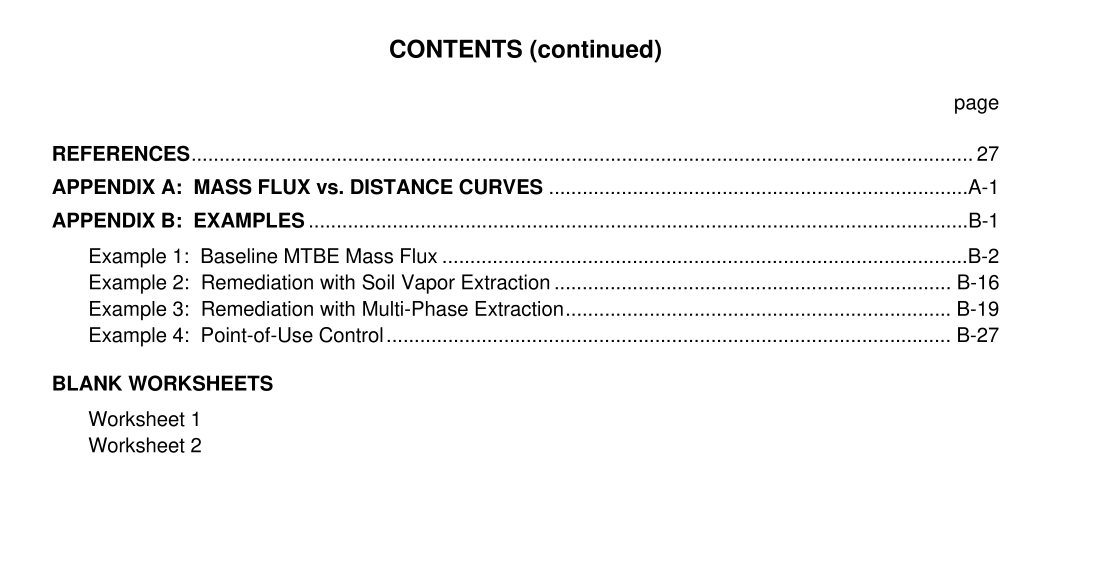API Publication 4730 pdf download

API Publication 4730 pdf download.Groundwater Remediation Strategies Tool
2.0 GENERAL GROUNDWATER REMEDIATION PROCESS (FLOWCHART
1) This groundwater remediation process works by estimating the baseline mass flux and remediation timeframe for various transport compartments, and then evaluating how different remedies reduce the mass flux and remediation timeframe in each transport compartment. The effects of an upgradient remedial action (such as remediating the vadose zone) on downgradient transport compartments is also considered. The general remediation process is shown in Figure 1 . 2.1 Preliminary and Detailed Site Characterization First, a preliminary site assessment is performed. If an action level is exceeded, then a detailed site assessment is conducted. It is recommended that characterization of MTBE sites be conducted using the methods presented in “Strategies for Characterizing Subsurface Releases of Gasoline Containing MTBE” (Nichols et al., 2000) (see box below). This document provides instructions on how to use risk-based decision making in the site characterization process.
Risk-informed decision making is a manage- ment strategy that adds exposure and risk considerations to the traditional technical, so- cial, and economic components of the correc- tive action process. The risk-informed ap- proach presented in this bulletin uses site- specific risk factors to help determine the appropriate level of assessment at oxygenate release sites. It includes a review of the various risk factors associated with oxygenate sources, pathways, and receptors. Based on these factors, three levels of assessment are recognized. The standard level is appropriate for the greatest number of sites: it includes moderate sample spacing with some vertical characterization, as well as horizontal charac- terization. The limited level is appropriate at sites with fewer risk factors: it includes relatively large sample spacing with emphasis on horizontal characterization. The detailed level is warranted for sites with the most risk factors: it requires the highest level of effort for each characterization task, with relatively close sample spacing, and extensive vertical characterization of chemical concentrations and hydraulic properties.Detailed information about receptors can nor- mally be obtained from a survey of nearby wells and land uses. Receptor characterization should consider current uses and probable future uses of affected groundwater. Once receptors are characterized and an initial level of effort is established, a subsurface investiga- tion may then be conducted to obtain detailed information about sources and pathways. The source and pathway data should be carefully reviewed as it is collected, and the level of assessment should be “upgraded” or “down- graded” accordingly. This bulletin includes a detailed overview of the tools and techniques used in the field for source and pathway characterization and subsequent monitoring at oxygenate release sites. Since traditional assessment approaches have been addressed in previous API publications, this bulletin focuses on newer technologies that allow rapid collection and field analysis of soil, soil-gas, and groundwater samples. The bulletin in- cludes a review of the expedited site assess- ment process, which is particularly well suited for oxygenate assessment. It also provides a comprehensive guide to modern direct-push assessment and monitoring tools, with empha- sis on their proper use at MTBE-affected sites.
Estimation of mass flux across one or more transects through an affected groundwater plume involves the following principal steps:
1. Characterize Plume Concentrations: For each selected plume transect, sufficient groundwater sampling points must be available to define i) the full width and thickness of the plume and ii) the distribution of contaminant concentrations within the plume. Either single-level or multilevel groundwater monitoring points may be used for this purpose. Multilevel monitoring points can provide a more detailed three-dimensional characterization of contaminant concentrations in groundwater. However, single-level groundwater monitoring networks, while less accurate than multi-level networks, can still provide sufficient accuracy to support a mass flux analysis at many sites.(NOTE: an alternative method is to use the concentrations from contour lines as measurement points. The locations where the transect intersects contour lines from plume maps can be used to construct flow areas for the mass flux calculations). 2. Characterize Groundwater Flow: To characterize the specific discharge (q) across each plume transect, representative measurements are required for both the hydraulic flow gradient (i) and the hydraulic conductivity (K) of the flow system (where q = K x i). The groundwater flow direction and hydraulic gradient for each segment of a transect line can be determined from a potentiometric surface contour map based on static water level measurements of available sampling points. Representative measurements of the hydraulic conductivity of the groundwater-bearing unit should be obtained at one or more locations, using appropriate slug test or pumping test methods. 3. Select Plume Transects: To characterize mass flux, transects should be located at points where sufficient data are available to define affected groundwater concentrations and specific discharge, as defined in Steps 1 and 2 above. For two-dimensional data (i.e., from single-screen monitoring wells), the transect will represent a line extending across the full width of the plume, perpendicular to the direction of groundwater flow (see Figures 2 and 3). For uniform flow fields, this transect will be a straight line, but, for converging or diverging flowlines, the transect will be curvilinear in shape. For three-dimensional data (i.e., from multilevel monitoring wells), the transect line will represent a vertical plane through the groundwater plume, positioned perpendicular to groundwater flow (see Figures 4 and 5).









